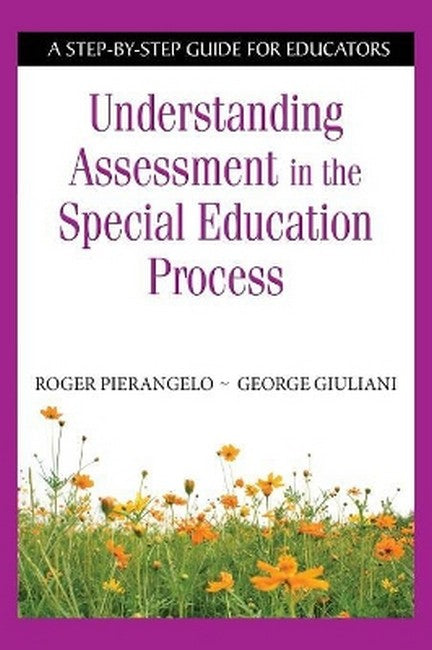Roger Pierangelo is an associate professor in the Department of Special Education and Literacy at Long Island University. He has been an administrator of special education programs and served for eighteen years as a permanent member of Committees on Special Education. He has over thirty years of experience in the public school system as a general education classroom teacher and school psychologist, and is a consultant to numerous private and public schools, PTAs, and SEPTA groups. Pierangelo has also been an evaluator for the New York State Office of Vocational and Rehabilitative Services and a director of a private clinic. He is a New York State licensed clinical psychologist, certified school psychologist, and a Board Certified Diplomate Fellow in Child and Adolescent Psychology and Forensic Psychology. Pierangelo is currently president of The National Association of Special Education Teachers, executive director of The American Academy of Special Education Professionals, and vice-president of The National Association of Parents with Children in Special Education. Pierangelo earned his BS degree from St. John's University, his MS from Queens College, Professional Diploma from Queens College, PhD from Yeshiva University, and Diplomate Fellow in Child and Adolescent Psychology and Forensic Psychology from the International College of Professional Psychology. He is a member of the American Psychological Association, New York State Psychological Association, Nassau County Psychological Association, New York State Union of Teachers, and Phi Delta Kappa. Pierangelo is the coauthor of numerous books, including The Big Book of Special Education Resources and The Step-by-Step Book Series for Special Educators. George Giuliani is an assistant professor at Hofstra University's School of Education and Allied Health and Human Services, in the Department of Counseling, Research, Special Education, and Rehabilitation. He is the executive director of the National Association of Special Education Professionals, president of the National Association of Parents with Children in Special Education (NAPCSE), vice-president of the National Association of Special Education Teachers, and an educational consultant for various school districts. He has provided numerous workshops for parents and teachers on a variety of special education and psychological topics. Giuliani earned Board Certification as a Diplomate Fellow in Child and Adolescent Psychology and Forensic Psychology from the International College of Professional Psychology. Giuliani is also a New York State licensed psychologist, certified school psychologist, and has an extensive private practice focusing on children with special needs. He is a member of the American Psychological Association, New York State Psychological Association, the National Association of School Psychologists, Suffolk County Psychological Association, Psi Chi, American Association of University Professors, and the Council for Exceptional Children. Giuliani earned his BA from the College of the Holy Cross, MS from St. John's University, JD from City University Law School, and PsyD from Rutgers University, The Graduate School of Applied and Professional Psychology. Giuliani is the coauthor of numerous books, including The Big Book of Special Education Resources and The Step-by-Step Book Series for Special Educators.
Request Academic Copy
Please copy the ISBN for submitting review copy form
Description
About the Authors Acknowledgments Introduction Step I. Understanding Assessment and Special Education Assessment Importance of Assessment Purpose of Assessment The Difference Between Testing and Assessment Role of the Education Professional in the Special Education Process Assessment and Federal Law Step II. Understanding and Identifying Students Who Might Exhibit a Disability Understand the Meaning of a "High Risk" Student High Risk Students: Determine the Severity of the Problem Understand How Tension Affects High Risk Students Become Familiar With Common Avoidance Behavior Patterns Exhibited By High Risk Students Conclusions Step III. Understanding and Making a Referral to the Child Study Team Understand Your Role in the Referral Process Learn About the Membership of the CST Understand What Takes Place at the CST Meeting Learn About the Various Sources of Information Available on Your Student Understand the Options of the CST Conclusions Step IV. Understanding and Obtaining Parental Informed Consent for Assessment Step V. Understanding the Requirements of an Evaluation for a Suspected Disability Step VI. Understanding the MDT and the Comprehensive Assessment Understand the Responsibilities of the Team Assigned to Do the Comprehensive Assessment: The Multidisciplinary Team Understand the Membership of the MDT Step VII. Understanding the Various Methods of Assessment Options Available to the MDT What Is a Comprehensive Assessment? What Is Norm-Referenced Testing? Primary Areas of Assessment Conclusions Step VIII. Understanding Basic Statistics and Scoring Terminology Used in Assessment Age Equivalent Alternate Forms Reliability Concurrent Validity Construct Validity Content Validity Correlation Criterion-Related Validity Grade Equivalent Interrater Reliability Mean Median Mode Range Percentile Rank Predictive Validity Raw Scores Reliability Reliability Coefficients Scaled Scores Split-Half Reliability or Internal Consistency Standard Deviation Standard Error of Measurement Standard Scores Stanine Test-Retest Reliability T Scores Validity z Scores Conclusions Step IX. Understanding Students' Behavior During the Assessment Process Understand the Possible Effects of Examiner Variables Understand How to Observe Overt Signs of Tension Understand Behaviors That Are Observed . . . Understand Behaviors That Provide Insight Into the Student's Organizational Abilities During the Assessment Process Conclusions Step X. Understanding the Components of a Professional Evaluation Report Practical Guidelines for Writing a Professional Evaluation Report Understand the Components of the Report Step XI. Understanding What Is Required for a Presentation to the IEP Committee Concluding Thoughts Glossary References and Suggested Readings Index
"Short and to the point-a huge advantage! Easy to read and to understand. A must-have for every school building in every district." -- Rachel Aherns, Collaborative Resource Teacher "This book clearly does just what it promises, providing a step-by-step guide about the special education assessment process." -- Renee J. Ponce-Nealon, Third-Grade Teacher "From understanding basic statistics to understanding the foundations of the MDT, this is a powerful tool that educators need." -- California Bookwatch, January 2008

